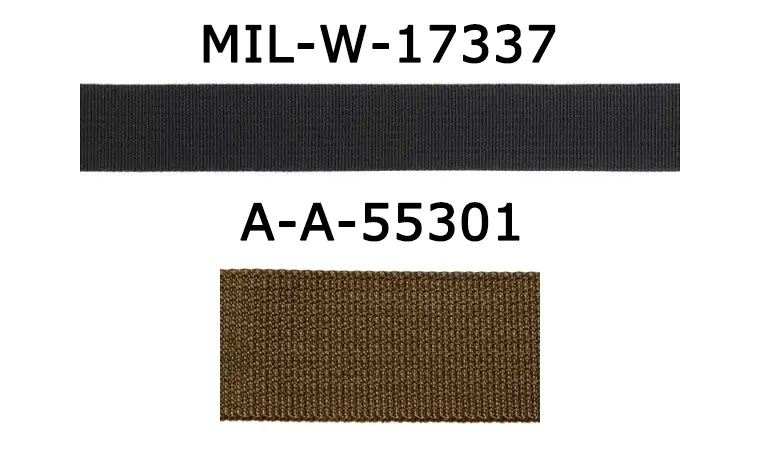In the world of tactical and military gear, precision is not just a goal—it's a necessity. The performance of a soldier's equipment can be a matter of mission success or failure. At the heart of this equipment lies a critical component: Mil-Spec webbing. But not all military-grade webbing is created equal. The sheer number of specifications can be daunting, as we covered in our general guide to Mil-Spec standards.
As a manufacturer, we frequently field questions about two of the most common nylon webbing specifications: **MIL-W-17337** and **A-A-55301**. While they may seem similar at first glance, their subtle differences in construction and performance have massive implications for product design. Choosing the wrong one can compromise the integrity and functionality of your gear. This guide will provide a deep dive into these two standards to ensure you make the right choice.
The Classic Workhorse: Understanding MIL-W-17337
MIL-W-17337 is one of the most established and versatile webbing specifications. It’s known for its durability and relatively flexible hand-feel, making it comfortable for applications that come in contact with the user. Typically, it has a slightly thicker profile and a looser weave compared to its counterpart.
This standard is often the go-to choice for general-purpose straps on a wide range of military equipment. Its combination of strength and flexibility makes it ideal for:
- Rifle Slings and Gun Slings
- Backpack Straps and Cinching Straps
- Equipment Tie-Downs and General Purpose Straps
- Chin Straps and Helmet Suspensions
The Modern MOLLE Foundation: Deciphering A-A-55301
A-A-55301 is a newer specification that has become the backbone of modern tactical gear, largely due to the rise of PALS (Pouch Attachment Ladder System) webbing used in MOLLE (Modular Lightweight Load-carrying Equipment) systems. Its construction is flatter, thinner, and has a much tighter, more consistent weave. These are not just aesthetic differences; they are critical for performance.
The primary advantage of A-A-55301 is its exceptional dimensional stability. For MOLLE systems to function correctly, the webbing ladders must be perfectly spaced and not stretch or sag under load. This is where A-A-55301 excels, making it the non-negotiable choice for any product requiring MOLLE compatibility, such as tactical vests and plate carriers.
Head-to-Head Comparison: Key Differences at a Glance
Let's break down the technical differences between these two nylon webbing standards to make the choice clearer.
| Feature | MIL-W-17337 | A-A-55301 |
|---|---|---|
| Weave & Texture | Slightly looser, more pronounced texture | Very tight, flat, and smooth weave |
| Thickness | Generally thicker and more robust feeling | Thinner and more streamlined |
| Flexibility / Stiffness | More flexible and pliable "soft hand" | Stiffer and more rigid for dimensional stability |
| Breaking Strength (1-inch) | Class 2 offers a 1,000 lbs rating | Type III offers a 1,000 lbs rating |
| Primary Application | General use straps, slings, carry handles | MOLLE/PALS systems, binding tape, load-bearing equipment |
Why Choosing the Right Spec is Mission-Critical
The danger of choosing the wrong webbing material is not always immediate failure, but rather a gradual degradation of performance. Using the more flexible MIL-W-17337 in a MOLLE system, for example, could cause pouches to sag and shift, creating noise and discomfort for the operator. Conversely, using the stiffer A-A-55301 for a rifle sling might make it less comfortable and harder to adjust quickly.
Furthermore, many government contracts will explicitly specify one standard over the other. Ensuring compliance is essential for any brand operating in the defense sector. Beyond camouflage patterns and IRR compliance, the base material's structural integrity is paramount.
Conclusion: The Right Tool for the Job
Ultimately, the choice between MIL-W-17337 and A-A-55301 comes down to the intended application. Think of it this way:
- For **general-purpose strength and flexibility** where user comfort is a factor (like slings and straps), **MIL-W-17337** is an excellent and proven choice.
- For **precision-critical applications** where dimensional stability is non-negotiable (like MOLLE systems), **A-A-55301** is the only correct answer.
As a core component of life-saving equipment, military webbing demands manufacturing excellence. Whether your design calls for the robust flexibility of MIL-W-17337 or the unyielding stability of A-A-55301, our production lines are equipped to deliver fully compliant, mission-ready webbing. We have the expertise to guide you to the correct material for your needs. Contact our tactical gear specialists to get a quote for your project.

